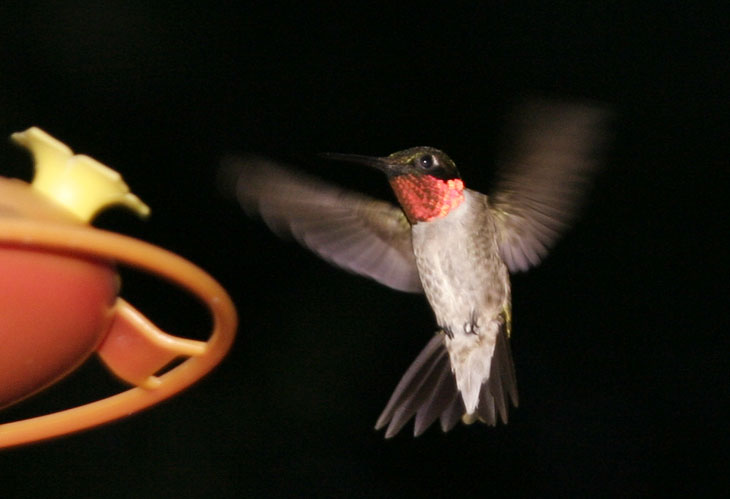
Just a peek at one of the male hummingbirds that visit my feeder. I still haven’t set up some natural feeder plants for a better prop than my plastic feeder – it’s been low on the priority list.
No, this wasn’t taken at night – this actually shows the nature of photographing some types of subjects. In order to try for some sharpness on a fast moving and jittery subject like a hummingbird, I was shooting at 1/1000 of a second with a high-speed strobe. The strobe provided light for the subject, but this was much brighter than the ambient background light, early evening with light overcast. What happened is, the brief moment that the shutter was open didn’t allow enough light from the distant background trees to come in, so they’re underexposed almost to black. This gives a very unnatural look to the image, so a better time to try for this is when the sun is brightly illuminating the background.
This happens often in closeup/macro work as well, for a different reason that still has the same result. At high magnifications, depth of field drops way down, meaning that sharp focus does not extend very far – the eyes of the bug might be sharp, but the wings or hindbody are well out of focus. To try and combat this, a small aperture is used, which increases the depth of field but admits much less light. So the same thing happens – the strobe can illuminate the subject adequately, but won’t carry to the background, which then remains dark.
In some cases, a second strobe can be used to illuminate the background, but this can be tricky – too much, too little, or poorly-aimed light causes this to fail. When you’re shooting tiny subjects while trying to keep what’s exactly behind them properly lit, aiming isn’t as simple as you might think, especially when the second strobe is probably mounted on a bracket attached to your camera, which you are then moving around for the best framing (and quite possibly trying to keep your moving subject in sharp focus.) You can also try to use natural light, which would mean leaving the shutter open for a longer exposure to compensate for the reduced light through the aperture. Fine in theory, provided your camera is locked on a tripod, your subject isn’t deciding to wander about, and the wind is completely dead.
Ah, the wind! The macro photographer’s sworn enemy. You never realize how often there’s even a tiny breeze until you’re focused on a bug on a leaf that continually drifts in and out of focus. Is it any wonder that I’ve done detailed shots of insects (such as here) while they perched on a leaf or twig that was then held in a set of tiny clamps on my desk, indoors away from the wind and under a balanced set of lights? Yes, we’re talking cheating yet again, which would imply that this was easier, wouldn’t it? And not requiring lots of camera repositioning as the subject wanders up and down the setting, across the clamps, facing the wrong way, and generally behaving like a hyperactive toddler. Actually, much worse – you can jingle your keys and get a toddler’s attention for 1.8 seconds…
It wouldn’t seem like photos of bugs, or even birds at a feeder, should be even remotely challenging, but there you have it. It’s all about the light, and how you make use of it.



















































